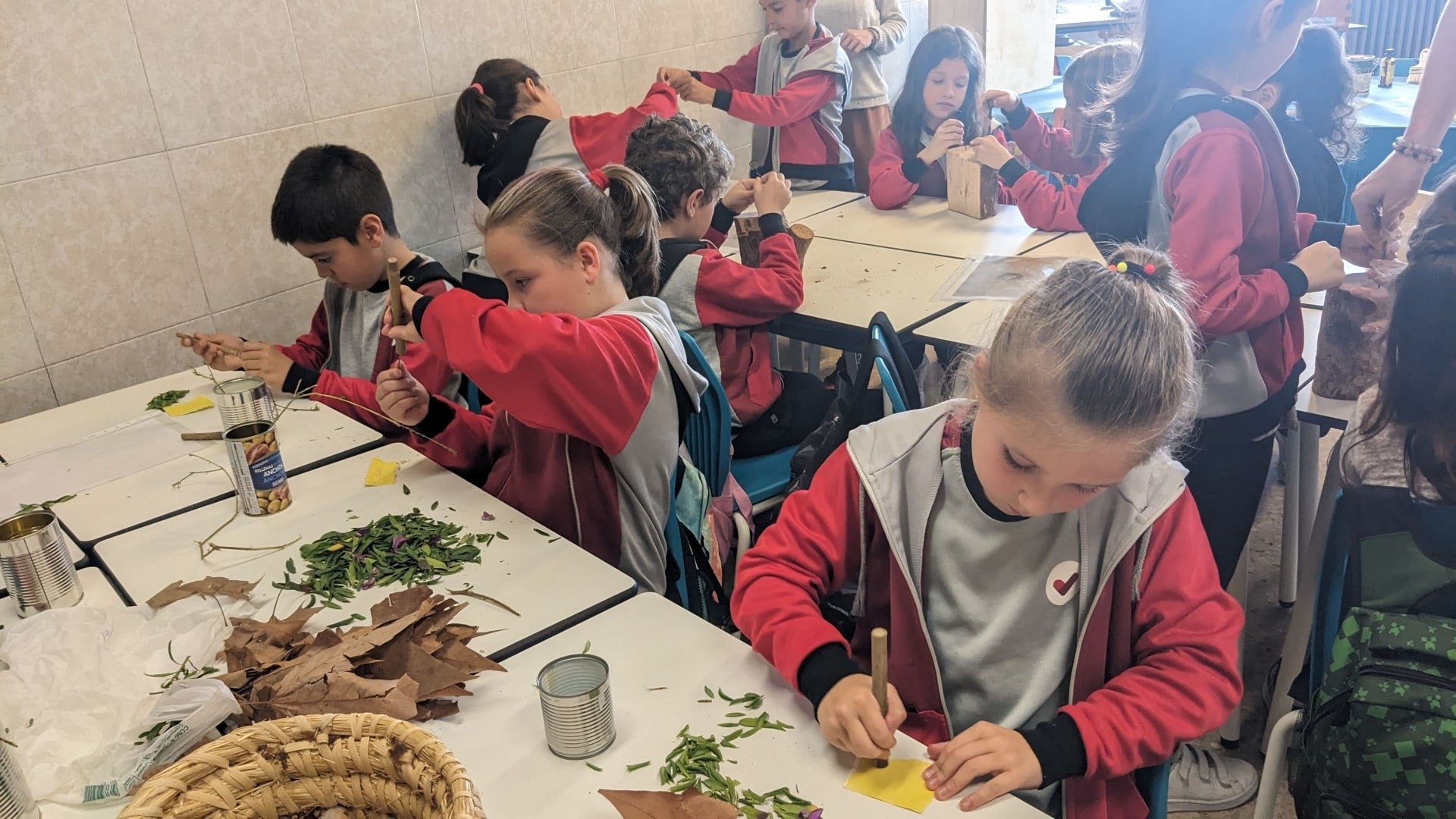
"What would happen if there were no bees?" - Bee Nesting Project at Joaquima Vedruna School
Posted on
I am Marta Bayona. I am an environmentalist. I worked for ten years at a public company of the then Department of Environment of the Generalitat de Catalunya, mapping forests. With the great crisis around 2012, I was out of work and took the opportunity to reflect on where I wanted to direct my professional life. After some personal work, I decided to study childhood. I wanted to work with people and do Environmental Education from school institutions.

Why did you decide to create a project about bees with your students in the Joaquima Vedruna School?
The previous year, with the same students, we did a forest project throughout the third term. On the outings in the forest, some students showed their distaste for certain insects, such as bees. We took advantage of this casuistry to make a scene in the classroom, with all bees printed and stuck on the windows, to draw their attention to the subject again.
The surprise and, once they laid out the previous ideas and what they wanted to learn, made the initial question "What would happen if there were no bees?" arise from them in a very natural and unforced way.
They also remembered the reflection we did the previous year when a child said in the forest that he wanted to kill the bee and we told him that he couldn't because, among many other things, it was a protected species.

How do the Bees fit into the educational framework of the school?
In the new curriculum there is no verticality of content, not even specific content as such, so any project is valid if it contemplates the knowledge, vectors and competences that the law frames. Any project with a socio-environmental perspective has a place in the vector "democratic citizenship and global awareness".
From this approach, the topic in question allows you to approach and also work on the rest of the vectors and skills, or a large part. In our case, looking at competences, we created a globalised learning situation that helped to develop digital, linguistic, civic, scientific, metacognitive and entrepreneurial competence.
The bee nest was the final product to provide a solution to the environmental problem investigated by the students.

What is the added value that Silvestres association has contributed by working on this project about bees?
We were very clear that the project had to start from a student question, that it had to have a part of research and an affordable proposal to help solve the problem.
For me, in a learning situation, it is very important that there is this final product that transforms the space and the people.
In front of the school there is an insect hotel, which we had gone to see more carefully during the research phase, and the students' proposal was headed here. We were thinking of asking the families for help, but we were running out of time, because the Easter holidays were coming up, and a person from the school who knew the project of the Silvestres association recommended the workshops to us. We didn't think about it.
Sometimes at school we have good ideas, but not the knowledge or the material to do things in the time space we have programmed them. The workshops were very suitable for our purpose. They allowed us to put the researched knowledge into practice, expand it thanks to the experts who came, and that same day we had a product that answered many questions and allowed us to generate new hypotheses.
We ended up putting three nests for different species of bees in the yard, with a very clear objective visible to the entire educational community. At first, the transformation was supposed to be bigger and include the honey-bearing flowers, but the students took them to water, grow and be able to transform their balcony.
Do you know of a school that has a beehive or has made a nest for swarms in the spring? How was the reception of the proposal? How did you experience it?
I don't know any schools specifically, but I know some schools in Barcelona that have naturalized their playgrounds with the help of the City Council and some European project, the coolschools. I am sure that these schools contemplate the nests for insects, as they note that the renaturalization of the playground has increased the biodiversity of both this and the city. These playgrounds improve student attention, diversify students' play and creativity, increase accessibility and equity, educate to generate climate solutions, improve students' cognitive and behavioral development, etc.
In fact, in our learning situation, one of the students' hypotheses was that there was a possibility that no bees or swarms would come, because we have a very unnatural playground, with a lot of asphalt. Our surprise dismantled our hypotheses and the colonization of the hive by a swarm, managed to beat our initial challenges by far. We lived it with enthusiasm, on the part of the whole community. The impact on the whole school was so great that our first year ESO godfathers and godmothers asked us to give them a talk about bees and their problems. We had a debate about non-native species and native species.

What benefits do you think working with bees brings to students? What changes have you noticed in the attitude of the students since the beehive project was launched?
The benefits of working with students on biodiversity are manifold, especially if they can experience it up close. We see it as a long way to do a renaturation of our yard right now, which attracts more species of insects, because financial resources are needed to do it, but we do see it feasible to do small actions like this year.
The next step is to resume the school garden, plant honey-bearing flowers and continue the project, so that other students can experience it more closely. We believe that the students who considered killing the insects in the forest, now know that this is not good because bees have a very important function within the ecosystem and within our food chain.
Environmental Education helps them to be more empathetic, more respectful, more creative, have a more scientific and complex vision of systems, expand their view of the world around them,... It also helps to create emotional bonds with their peers and the teachers In addition, the yard is used by everyone and, more than others, felt curiosity about those nests and the illusion of having them.

What challenges did you have to overcome during this project?
The students soon saw that we had to invite the management of the school, to support us in installing the nests. After listening to the students, the management of the center gave us the go-ahead without thinking about it.
The families who came to look for their sons and daughters and had doubts or fears about it were informed. There was always understanding and at no time was there any incident.
As a curiosity, let me tell you that there was a student with special needs, from other courses, who since he had detected the presence of bees, had the routine of going to see them every day and showed joy because were there He wanted to catch them, he wasn't afraid and the bees didn't hurt him. I think I connected more with them.

What are the future plans for the continuity and development of the project?
The idea is that in the following courses the learning situation will continue to be applied, with the relevant modifications that allow us to make the assessment, and continue to count on the collaboration of people who are experts in the subject.
There is also the possibility of seeing an organic beekeeper, introducing a more creative and artistic activity or even inviting the rest of the educational community to install the nests. I hope that we will continue to count on the collaboration of the Silvestres association.

What advice would you give to other schools interested in undertaking a similar project?
At the end of the year, when the students wrote about what they had done and learned that year in the second year, many referred to the learning situation of the bees as the project they had liked the most.
I recommend that all schools create quality learning situations that address socio-environmental issues like this (the Sustainable Development Goals), with a transformative final product, both of minds and spaces, and with the support of expert entities in the subject
LOMLOE makes it very easy for us to go down this path. We need to educate for sustainability and go further. Naturalize schools and expand learning spaces, outside the classroom.

On a personal level and as a teacher, how did you live the experience of the workshop and call of the bees with the association Silvestres? What has been the level of attention?
Silvestres association has encouraged us to close the learning situation with a higher quality than we had thought and has opened the door to encourage us to do more educational activities of this style.It is necessary to enrich the learning situations with entities that fill them with more meaning. The Silvestres association gave us important cognitive and emotional support to complete the project. Alliances are needed, making links.

Leave a comment: